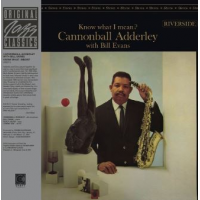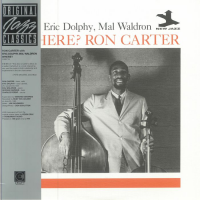Home » Jazz Articles » Multiple Reviews » OJC's Big Guns: Art Blakey, Cannonball Adderley, and Ron Carter
OJC's Big Guns: Art Blakey, Cannonball Adderley, and Ron Carter
 Art Blakey & The Jazz Messengers
Art Blakey & The Jazz Messengers Caravan
Craft Recordings
1962
Drummer Art Blakey was a very prolific recording artist throughout over three decades beginning in the 1950s. While his Blue Note tenure gave us over a dozen titles with his time-honored Jazz Messengers, the drummer also led a session for Impulse! and several more for Riverside during the same time period. One of his most prized Riverside titles, Caravan features the extended front line of Freddie Hubbard, Wayne Shorter and Curtis Fuller. With pianist Cedar Walton another key element to this edition, Shorter takes the lead in the composing department with "This is For Albert" being an absolute gem.
Recorded in the fall of 1962, the material on Caravan is equally split between originals and Tin Pan Alley trinkets. Much like he had previously done with "A Night in Tunisia," Blakey turns the title track into a percussive workout of bacchanalian proportions. "Skylark" is a showcase for Hubbard's herculean trumpet, while "In the Wee Small Hours of the Morning" gives Fuller a chance to shine with his own polished statement. Casting a wide soundstage, each instrument occupies its own palpable space in a mix that rivals and possibly surpasses previous audiophile reissues of this title.
 Cannonball Adderley
Cannonball Adderley Know What I Mean?
Craft Recordings
1962
At first consideration, the pairing of pianist Bill Evans and alto saxophonist Cannonball Adderley must have seemed like an odd combination of opposing viewpoints. Evans' muse was as reflective and inward as Adderley's seemed to be soulful and ebullient. Nonetheless, the results heard on 1962's Know What I Mean make the album a homerun in many ways. As if the music alone was not enough, the gorgeous cover cleverly features Adderley standing in front a display of sculptures from the Bertha Schaefer Gallery, in addition to a small cube that sports a portrait of Evans.
Evans is distinctively heard with rhythm mates Percy Heath and Connie Kay, both serving as members of the Modern Jazz Quartet at the time. The program includes some well-chosen standards, as well as Evan's own "A Waltz for Debby" and one of his favorite vehicles, the Earl Zindars line "Elsa." Adderley waxes romantic on "Goodbye," his tone and characteristic phrases illuminated brilliantly. By contrast, "Who Cares?" swings mightily with all the panache that marks Adderley's best work. Evans steps out of his comfort zone, matching the saxophonist's every move and making this a career highlight for both artists.
 Ron Carter
Ron Carter Where?
Craft Recordings
1961
It is interesting to note that while Ron Carter can boast the honor of being the most recorded jazz bassist in history, it is also worthy to consider that he was one of the first bassists to lead his own albums and feature himself on both bass and cello. His first endeavor in that arena would be the 1961 album Where?, recorded for Prestige Records' forward-thinking subsidiary New Jazz.
Utilizing his alto sax, bass clarinet and flute, Eric Dolphy really steals the show here even if he is not officially the leader. On "Rally" Dolphy's bass clarinet matches Carter's bass note for note on the intriguing opening melody. For "Softly as in a Morning Sunrise" Dolphy brings out his characteristic alto for a fiery romp that is one of the highpoints of the session. Sy Oliver's "Yes, Indeed" is a downhome number reminiscent of Ray Charles' muse, and yet Dolphy's flute manages to bring it up to date with mercurial lines of great momentum.
On "Bass Duet" and "Where?" Carter steps forward to display his admirable chops. If there is one caveat it might be that pianist Mal Waldron does not get much time in the solo spotlight. His accompaniment is still never less than whimsical, particularly on the swashbuckling "Saucer Eyes," one of Randy Weston's finest compositions. Equally selfless are bassist George Duvivier, who supplies the bass lines when Carter picks up his cello, and drummer Charlie Persip. More sizable efforts would be in the offing, yet this maiden voyage by Carter holds more than enough allure to make it worth checking out.
Associated equipment used for evaluation
VPI Scout 1.1 turntable with Soundsmith Aida Mk II cartridgeMusical Fidelity A3CR amplifier and preamp
Sutherland Insight phono preamp
Arcam SDS 50 SACD player
Bowers & Wilkins Nautilus 805 loudspeakers
Cardas cable and interconnects, Chang Lightspeed power conditioner
Solidsteel S3 Series audio rack
Tracks and Personnel
CaravanTracks: Caravan; Sweet 'n' Sour; In the Wee Small Hours of the Morning; This Is for Albert; Skylark; Thermo.
Personnel: Art Blakey: drums; Freddie Hubbard: trumpet; Wayne Shorter: saxophone; Curtis Fuller: trombone; Cedar Walton: piano; Reggie Workman: bass.
Know What I Mean?
Tracks: Waltz For Debby; Goodbye; Who Cares?; Venice; Toy; Elsa; Nancy (With The Laughing Face); Know What I Mean?
Personnel: Cannonball Adderley: alto saxophone; Bill Evans: piano; Percy Heath: bass; Connie Kay: drums.
Where?
Tracks: Rally; Bass Duet; Softly, As In A Morning Sunrise: Where?; Yes, Indeed; Saucer Eyes.
Personnel: Ron Carter: bass and cello; Eric Dolphy: bass clarinet, flute, alto sax; Mal Waldron: piano; George Duvivier: bass; Charlie Persip: drums.
< Previous
Bill Anschell / Brent Jensen: We Coul...
Next >
Bianca
Comments
About Art Blakey and the Jazz Messengers
Instrument: Band / ensemble / orchestra
Related Articles | Concerts | Albums | Photos | Similar ToTags
Multiple Reviews
Art Blakey And The Jazz Messengers
C. Andrew Hovan
United States
New York
New York City
Craft Recordings
Art Blakey
Freddie Hubbard
Wayne Shorter
Curtis Fuller
Cedar Walton
Bill Evans
Cannonball Adderley
Percy Heath
Connie Kay
Ron Carter
Eric Dolphy
Mal Waldron
Randy Weston
George Duvivier
Charlie Persip
For the Love of Jazz
 All About Jazz has been a pillar of jazz since 1995, championing it as an art form and, more importantly, supporting the musicians who create it. Our enduring commitment has made "AAJ" one of the most culturally important websites of its kind, read by hundreds of thousands of fans, musicians and industry figures every month.
All About Jazz has been a pillar of jazz since 1995, championing it as an art form and, more importantly, supporting the musicians who create it. Our enduring commitment has made "AAJ" one of the most culturally important websites of its kind, read by hundreds of thousands of fans, musicians and industry figures every month.




















